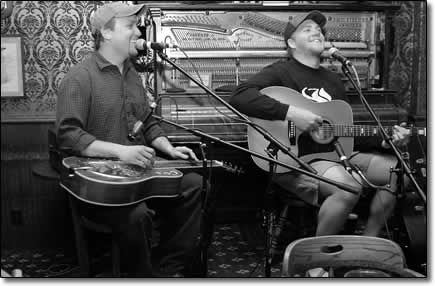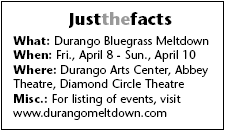|
A look at Durango’s deep bluegrass roots

|
|
Anders Beck and Travis Book, members of the Broke Mountain Bluegrass Band, get things rolling during a show at the Diamond Belle Saloon on Monday. Beck and Book represent a second generation of bluegrass players sprouting up in Durango, swift on the heels of a handful of local musicians who have kept the growing genre active since the early 1980s./Photo by Todd Newcomer.
|
by Amy Maestas
Growing up in Pennsylvania, Durango Dobro player Anders Beck fancied himself a "prep school
hippie." He preferred bands that jammed clanging chords and meshed melodies for minutes on end. When he moved to
Durango five years ago, Beck quickly changed his tune - literally.
 Beck says he found himself smack-dab in the middle of the "hotbed of bluegrass" music. Only 22 years old then, Beck's
retro-hippie generation didn't expose him much to a genre of music that, although more than 50 years old, has been
enjoying a surge in popularity the past decade. He heard more of the music, he says, because of its regional
popularity. Then when he attended the Telluride Bluegrass Festival for the first time, Beck, by happenstance, walked
into a workshop led by, among others, famous Dobro player Jerry Douglas. Beck says he found himself smack-dab in the middle of the "hotbed of bluegrass" music. Only 22 years old then, Beck's
retro-hippie generation didn't expose him much to a genre of music that, although more than 50 years old, has been
enjoying a surge in popularity the past decade. He heard more of the music, he says, because of its regional
popularity. Then when he attended the Telluride Bluegrass Festival for the first time, Beck, by happenstance, walked
into a workshop led by, among others, famous Dobro player Jerry Douglas.
"I knew immediately that I had to play the Dobro," he explains. "I never second-guessed it."
His is a typical story, some might say. After all, music is personal for most people, and those who are fanatics
often stumble upon instruments and genres in similar ways. But what Beck represents more than an unexpected Dobro
convert is a second generation of bluegrass players sprouting up in Durango. Swift on the heels of a handful of local
musicians who have kept the growing genre active since the early 1980s, Beck and a host of other twentysomethings are
evidence of how deeply rooted this style of music is in Durango - a laid-back town, predicated on earth-based
philosophies, thick weaves of kinship and creative outlets.
By proximity and by lifestyle, Durango's reputation as a breeding ground of bluegrass continues to strengthen. Pat
Dressen, longtime local musician and guitarist for The Badly Bent, says the musical genre flourishes here partly
because of its nearness to Telluride, where the legendary Telluride Bluegrass Festival has drawn thousands of
attendees for the past 32 years. The festival, which actually showcases more country and folk artists than bluegrass,
spills into outlying towns by drawing locals to a festival with such big-name musicians. Fans have close access to an
event that exposes them to different types of music that they would otherwise have to travel several hours to enjoy.
The other part of the popularity equation, Dressen says, is the way bluegrass music integrates with the culture and
way of life in Durango.
"It's the type of music that appeals to what once was a younger, hippie generation. People here came out of that
generation and the music has stuck around," Dressen explains.
Dressen also imagines that this style of music appeals to others the way it does to him: "The sound of wooden
instruments really speaks to my inner soul. The energy draws me to the beat, the drive and the liveliness."
Hugh Felt, banjo player for Down the Road and host of KSUT's "The Grass is Bluer," came out of that generation. One
of Felt's earliest forays into bluegrass fanaticism took place in 1969 when Felt went to see the late John Hartford
play in Greeley. A decade later, Felt saw acts like Lester Flatt and Hot Rize in concert, just weeks before Flatt
died. After playing, Flatt milled about the audience.
"He walked along and opened up his jacket, where he had these tapes he made. He hawked his wares and made it easy for
people to buy his music," Felt recalls. "From that time on, I've always felt there was such a sense that we are all
here together doing this."
That feeling has always been part of Durango, Dressen and Felt agree. Both musicians were pivotal in introducing
bluegrass to the local scene. A variety of venues provided a playing ground. Though bluegrass was far less part of
the mainstream music industry then, Dressen, Felt and a handful of other players formed bands that morphed into other
bands.

|
|
A Stelling Red Fox banjo hangs next to its counterparts on the wall of Canyon Music Woodworks recently. The music store has become a sort of hub among bluegrass musicians, who often stop in for some browsing as well as impromptu jams./Photo by Todd Newcomer.
|
That feeling has always been part of Durango, Dressen and Felt agree. Both musicians were pivotal in introducing
bluegrass to the local scene. A variety of venues provided a playing ground. Though bluegrass was far less part of
the mainstream music industry then, Dressen, Felt and a handful of other players formed bands that morphed into other
bands.
In fact, 11 years ago they helped start the Durango Bluegrass Meltdown, which returns to downtown venues this
weekend. The three-day festival features national and regional bands, as well as 14 local bands. Felt describes the
affair as "intimate," saying that is what distinguishes it from other regional events.
As the elements of bluegrass music have progressed, Durango audiences have gone with the flow, Dressen says. It's
easy for fans to get their bluegrass fix - or even introduction - from varied blends played on local public radio
stations KSUT and KDUR.
"Progressive bluegrass music goes so far sometimes that it isn't bluegrass anymore," Dressen says. "But all along,
the Durango bluegrass scene has kept one foot firmly planted in traditional styles."
This has remained true even as the entire bluegrass genre has been experiencing expanding attention and record sales
across the nation. Dressen says Alison Krauss & Union Station's rise to fame helped expose the music. Felt also
attributes the soundtrack from the movie "O Brother, Where Art Thou?"
"That was a big shot in the arm for string music," he says.
For these two longtime aficionados, the rise in popularity helped provide guidance to the younger generation in
Durango - those who were latching onto something their parents and elders were already espousing as soulful and
rootsy. Beck credits his generation of musicians for keeping bluegrass breathing and tangible for budding artists.
"Personally, I've learned a lot about this type of music from these kinds of people," says Beck. "It makes it
possible to get together with people you don't really know and share it with them."
The proof is in the number of awards these younger Durango-based musicians are racking up, along with the exposure.
The Broke Mountain Bluegrass Band is a first-place winner of the Rockygrass Band Competition. Among other credits,
guitarist and songwriter Benny Galloway wrote a song that national recording artist Del McCoury sings. Local Jason
Lampel is a second-place winner of the Rockygrass Banjo Contest.
Felt is excited that he and his peers paved the way for such nascent talent. He says he isn't a purist about
bluegrass, so he marvels at the new styles of playing that the younger generation is putting out.
"It is so cool to have known some of these kids early on," he says. "They've blossomed into extraordinary musicians.
They still revere the type of music they grew up on, but they have introduced a different style, too."
|